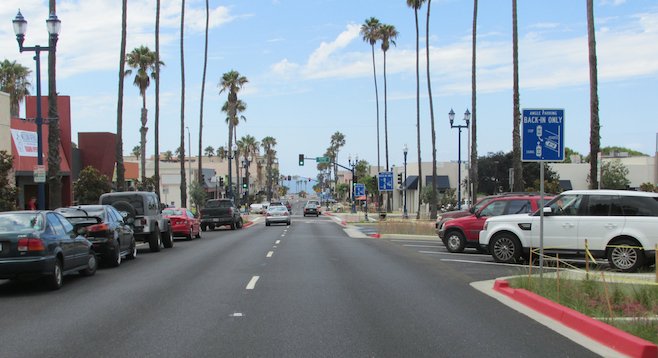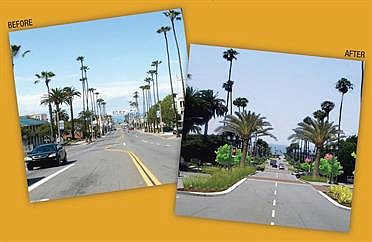 Facebook
Facebook
 X
X
 Instagram
Instagram
 TikTok
TikTok
 Youtube
Youtube

The Mission Avenue Improvement Project, started in October of 2013, was completed and open for vehicular and pedestrian traffic on August 19. Access to downtown has been beautified and improved for the better — almost.

One major change in the $2.5 million plan is not garnering favor with the public. The city installed back-in diagonal parking spaces in several areas — something new to most motorists.
Besides traffic flow, the major reason traffic engineers are supporting back-in parking is to help bicyclists. One is more likely to see an oncoming cyclist when pulling straight out of a diagonal space, rather than backing out.
I visited the area to gauge the public’s reaction and spoke to those who had used the new spaces.
Brooks from Vista said he had problems backing up and staying in between the lines. He prefers regular diagonal parking.
Bob Neal, chairman of the Oceanside Planning Commission, was one of the first to try the parking and said he loves the idea. “Studies show it is a safer way to park,” said Neal. His friend Tom, however, said, “It sucks. Someone will pull right up behind you and not allow you to back into a space.” While Bob was explaining the numerous studies and changes needed in our driving habits, Tom said, “It still sucks.”
Scott had parked near a restaurant where he and a friend were dining. He said he came to Mission Avenue often during the construction period and thought that for all the mess that lasted nine months, he expected a little more. He said the new parking arrangement is “very unusual.”
Several cities in California — Bridgeport, Chico, San Francisco, Santa Barbara, and Ventura – have switched to back-in diagonal parking in some areas. Leucadia’s ten-year plan for Coast Highway 101, adding five roundabouts and making the area more pedestrian- and bike-friendly, also calls for back-in parking.
An Oceanside official who didn’t want to be identified, said, “We have very strong pedestrian and bike organizations in this city. They make their thoughts known.”
(The limits of “bike-friendliness” may have been pushed since the 2014 law went into effect that requires motorists to give cyclists at least three feet of clearance when passing. A captain of another city’s police agency told me, after the new law was passed, that his department’s number-one citizen complaint about traffic and safety is cyclists not obeying stop signs, red lights, and turning regulations. Enforcement of violating cyclists has gone up in that nearby coastal town. )
The Oceanside project was also designed to enhance the entrance into town, as tourists come off I-5 heading west on Mission Avenue. The new streetscape project narrows the road to a one-way street and draws visitors onto Coast Highway, the beach, pier, and new high-rise hotels. The ocean is clearly the centerpiece at the end of Mission Avenue.
The five-block project widened sidewalks from 5 to 30 feet, added new landscaping, irrigation, street furniture, and decorative lighting. Several restaurants along the stretch have already established sidewalk-dining areas.
Gumaro Escarcega, the program manager for Oceanside Main Street (a chamber of commerce–type organization) points out that since construction began, five new restaurants on Mission have opened or will soon: Mission Avenue Bar & Grill, Sumo Hut Sushi, Maui Wowy, Alfredo’s Mexican, and an as-yet-unnamed Italian place under construction.


The Mission Avenue Improvement Project, started in October of 2013, was completed and open for vehicular and pedestrian traffic on August 19. Access to downtown has been beautified and improved for the better — almost.

One major change in the $2.5 million plan is not garnering favor with the public. The city installed back-in diagonal parking spaces in several areas — something new to most motorists.
Besides traffic flow, the major reason traffic engineers are supporting back-in parking is to help bicyclists. One is more likely to see an oncoming cyclist when pulling straight out of a diagonal space, rather than backing out.
I visited the area to gauge the public’s reaction and spoke to those who had used the new spaces.
Brooks from Vista said he had problems backing up and staying in between the lines. He prefers regular diagonal parking.
Bob Neal, chairman of the Oceanside Planning Commission, was one of the first to try the parking and said he loves the idea. “Studies show it is a safer way to park,” said Neal. His friend Tom, however, said, “It sucks. Someone will pull right up behind you and not allow you to back into a space.” While Bob was explaining the numerous studies and changes needed in our driving habits, Tom said, “It still sucks.”
Scott had parked near a restaurant where he and a friend were dining. He said he came to Mission Avenue often during the construction period and thought that for all the mess that lasted nine months, he expected a little more. He said the new parking arrangement is “very unusual.”
Several cities in California — Bridgeport, Chico, San Francisco, Santa Barbara, and Ventura – have switched to back-in diagonal parking in some areas. Leucadia’s ten-year plan for Coast Highway 101, adding five roundabouts and making the area more pedestrian- and bike-friendly, also calls for back-in parking.
An Oceanside official who didn’t want to be identified, said, “We have very strong pedestrian and bike organizations in this city. They make their thoughts known.”
(The limits of “bike-friendliness” may have been pushed since the 2014 law went into effect that requires motorists to give cyclists at least three feet of clearance when passing. A captain of another city’s police agency told me, after the new law was passed, that his department’s number-one citizen complaint about traffic and safety is cyclists not obeying stop signs, red lights, and turning regulations. Enforcement of violating cyclists has gone up in that nearby coastal town. )
The Oceanside project was also designed to enhance the entrance into town, as tourists come off I-5 heading west on Mission Avenue. The new streetscape project narrows the road to a one-way street and draws visitors onto Coast Highway, the beach, pier, and new high-rise hotels. The ocean is clearly the centerpiece at the end of Mission Avenue.
The five-block project widened sidewalks from 5 to 30 feet, added new landscaping, irrigation, street furniture, and decorative lighting. Several restaurants along the stretch have already established sidewalk-dining areas.
Gumaro Escarcega, the program manager for Oceanside Main Street (a chamber of commerce–type organization) points out that since construction began, five new restaurants on Mission have opened or will soon: Mission Avenue Bar & Grill, Sumo Hut Sushi, Maui Wowy, Alfredo’s Mexican, and an as-yet-unnamed Italian place under construction.
Comments